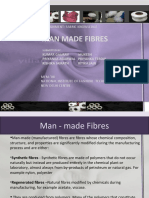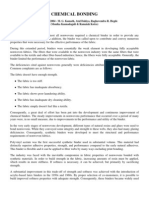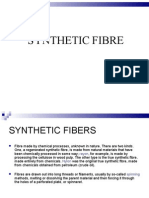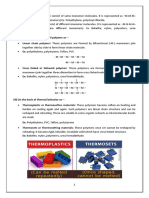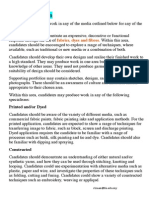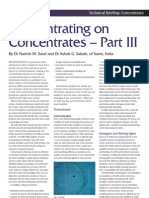What Is Nylon?
What Is Nylon?
Uploaded by
Dinia MedianiCopyright:
Available Formats
What Is Nylon?
What Is Nylon?
Uploaded by
Dinia MedianiOriginal Description:
Original Title
Copyright
Available Formats
Share this document
Did you find this document useful?
Is this content inappropriate?
Copyright:
Available Formats
What Is Nylon?
What Is Nylon?
Uploaded by
Dinia MedianiCopyright:
Available Formats
NYLON
1. What is Nylon?
Nylon is a generic designation for a family of synthetic polymers, based on aliphatic or semi-
aromatic polyamides. It is made of repeating units linked by amide links similar to the peptide
bonds in proteins. Nylon polymers have found significant commercial applications in fabric and
fibers, in shapes, and in films. and the types of nylon are as follows :
Nylon 66
Nylon 6
Nylon 510
Nylon 1,6
Monomers
Diamines
Polymers
Homopolymers
2. Properties of nylon
Pleats and creases can be heat-set at higher temperatures
More compact molecular structure
Better weathering properties; better sunlight resistance
High melting point (256 °C/492.8 °F)
Superior colorfastness
Excellent abrasion resistance
High elongation
Excellent abrasion resistance
High resistance to insects, fungi, animals, as well as molds, mildew, rot and many chemicals
3. Applications
Nylon is used in the garment and home furnishing industry. However, due to its higher price and
lesser wrinkle resistance, it has been replaced by polyester in many garment products. Yet, it
remains an important fiber for more demanding applications, including tire cords, ropes, seat
belts, hoses, conveyer belts, carpets, parachutes, racket strings, sleeping bags, tents, and
various civil engineering materials.
4. How is Nylon made?
Nylon, like other plastics, typically starts with the distillation of hydrocarbon fuels into lighter
groups called “fractions” some of which are combined with other catalysts to produce plastics
(typically via polymerization or polycondensation. The actual process for Nylon production falls
into one of two methodologies. The first involves the reaction of monomers with amine (NH2)
groups reacting with carboxylic acid (COOH). The second involves the reaction of diamine (a
molecule with 2 x NH2 groups) with dicarboxylic acid (a molecule with 2 x COOH groups).
Nylon is made when the appropriate monomers (the chemical building blocks which make up
polymers) are combined to form a long chain via a condensation polymerisation reaction.
The water is removed from the production process as its continued presence stops the creation
of more polymer.
The polymer chain can be made up of over 20,000 monomer units, connected together via an
amide group, which contains a nitrogen atom.
The nylon molecules are very flexible with only weak forces, such as hydrogen bonds, between
the polymer chains, which tend to tangle randomly. The polymer has to be warmed and drawn
out to form strong fibres.
5. Nylon Advantages & Disadvantages
1. Advantages:
Lightweight
Exceptional strength
Abrasion resistant
Easy to wash
Resists shrinkage and wrinkles
Resilient, pleat retentive
Fast drying, low moisture absorbency
Can be pre-colored or dyed in a wide range of colors
Resists damage from oil and many chemicals
2. Disadvantages:
Static and pilling
Poor resistance to sunlight
Low absorbency
Picks up oils and dyes in wash
Heat sensitive
You might also like
- LIDOCAINEDocument4 pagesLIDOCAINEmeesterNo ratings yet
- Man Made Fibres: Assignment: Fabric KnowledgeDocument37 pagesMan Made Fibres: Assignment: Fabric Knowledgeangurdevi100% (2)
- Nylon Polymers Book-Degradation and Stabilization of Nylon PolymersDocument120 pagesNylon Polymers Book-Degradation and Stabilization of Nylon PolymersWilliam H. BasingerNo ratings yet
- Total Colouring Matters Volume 4Document4 pagesTotal Colouring Matters Volume 4aria1354No ratings yet
- Nylon Is A Generic Designation For A Family ofDocument2 pagesNylon Is A Generic Designation For A Family ofSreejith S NairNo ratings yet
- Nylon (Textiles Industry) Organic Chemistry Assignment SlideDocument21 pagesNylon (Textiles Industry) Organic Chemistry Assignment SlideEitrah Tasnim Mohamat KasimNo ratings yet
- NylonDocument2 pagesNylonlieza_0726100% (2)
- Unit Iv Polymers - PPTDocument69 pagesUnit Iv Polymers - PPTAbhishek GuptaNo ratings yet
- Nylon 66Document5 pagesNylon 66Novelia Ananda FitrilaNo ratings yet
- NylonsDocument8 pagesNylonsUma MaheswariNo ratings yet
- Material Science ContentDocument23 pagesMaterial Science ContentHoongNo ratings yet
- Polymer: Types of PolymersDocument6 pagesPolymer: Types of PolymersSarah SheikhNo ratings yet
- Acrylic FibreDocument6 pagesAcrylic FibreRauf SyahNo ratings yet
- MMFDocument8 pagesMMFTushar BiswasNo ratings yet
- Material Science ContentDocument24 pagesMaterial Science ContentHoongNo ratings yet
- Polymers-Prep, Props, UsesDocument7 pagesPolymers-Prep, Props, UsesHarshal A ShahNo ratings yet
- Ahmed AssignmentDocument13 pagesAhmed AssignmentTalal AshrafNo ratings yet
- Polycarbonates, Polyamides and PolyurethaneDocument8 pagesPolycarbonates, Polyamides and Polyurethanecopperfieldfrank3No ratings yet
- Polymer Process Industries PPE-202: Dr. Farhan SaeedDocument16 pagesPolymer Process Industries PPE-202: Dr. Farhan SaeedHamza ArshadNo ratings yet
- Polymers ClassDocument17 pagesPolymers Classmilkiyashayilu58No ratings yet
- Material ScienceDocument5 pagesMaterial Scienceadeel1988No ratings yet
- Properties of Man-Made Fibers: 1. AcetateDocument10 pagesProperties of Man-Made Fibers: 1. AcetateARYAN RATHORENo ratings yet
- Adipic Acid & NylonDocument28 pagesAdipic Acid & NylonjanNo ratings yet
- Synthetic Fiber & PlasticDocument10 pagesSynthetic Fiber & PlasticPooja MekalaNo ratings yet
- TextileDocument3 pagesTextileDana MierluţNo ratings yet
- Chemical BondingDocument22 pagesChemical BondingKunal Kumar100% (2)
- Chemisty of Textile Fibers and Their PropertiesDocument21 pagesChemisty of Textile Fibers and Their Propertiesnalaka.sampathNo ratings yet
- Synthetic Fibres2Document78 pagesSynthetic Fibres2kamaldeepsinghNo ratings yet
- Nonwoven CombinedDocument106 pagesNonwoven CombinedTarun Kumar100% (1)
- Chem423FL1-5Polymer ProcessingDocument33 pagesChem423FL1-5Polymer ProcessingMd Mehrab Alam ShayikhNo ratings yet
- Spandex Fiber: Dorlastan.) Invista, Radicispandex CorporationDocument20 pagesSpandex Fiber: Dorlastan.) Invista, Radicispandex CorporationShantnu MittalNo ratings yet
- Common Condensation PolymersDocument32 pagesCommon Condensation PolymersShahriar SaifNo ratings yet
- Synthetic Fibre-Wps OfficeDocument3 pagesSynthetic Fibre-Wps Officepallab nathNo ratings yet
- UNIT-II Plastics & Lubricants 2024Document55 pagesUNIT-II Plastics & Lubricants 2024Yeonseo KangNo ratings yet
- Nylon (Textiles Industry) Organic Chemistry AssignmentDocument18 pagesNylon (Textiles Industry) Organic Chemistry AssignmentEitrah Tasnim Mohamat Kasim100% (1)
- Materials Science Polymers 1) Types of Polymer (A) PlasticDocument8 pagesMaterials Science Polymers 1) Types of Polymer (A) PlasticMeldy Grace Mantala ComandanteNo ratings yet
- Meraj Siddiqui PolymersDocument11 pagesMeraj Siddiqui PolymersMeraj SiddiquiNo ratings yet
- Presentation 1Document8 pagesPresentation 1Shahood JuttNo ratings yet
- Synthetic Fibres2Document78 pagesSynthetic Fibres2nitishkohliNo ratings yet
- Unit 3 - Part 2 NewDocument9 pagesUnit 3 - Part 2 NewOfficial WorkNo ratings yet
- ZYTDGeDocument62 pagesZYTDGeAnonymous JIRIzeiJ6ONo ratings yet
- Fs Final AssignmentDocument21 pagesFs Final AssignmentAkanksha RamanNo ratings yet
- Polymers CH 101 (Updated Version) FALL 22Document50 pagesPolymers CH 101 (Updated Version) FALL 22Haider AliNo ratings yet
- POLYMERSDocument26 pagesPOLYMERSnyoy yoyNo ratings yet
- Lecture 5Document38 pagesLecture 5Nadeeka TisseraNo ratings yet
- Ias 4 4 275 284 PDFDocument10 pagesIas 4 4 275 284 PDFHarjinder SinghNo ratings yet
- Unit IV PolymerDocument25 pagesUnit IV PolymerYugandhar PatilNo ratings yet
- Comparative Study of Nylon 11 (Polyamide) and PCDT (Polyester)Document15 pagesComparative Study of Nylon 11 (Polyamide) and PCDT (Polyester)نوشاد علیNo ratings yet
- Raw Materials of Technical TextilesDocument31 pagesRaw Materials of Technical TextilesTanmoy ChoudhuryNo ratings yet
- c4 PolymerDocument9 pagesc4 PolymerTeoh YuanxinNo ratings yet
- Chemical BondingDocument21 pagesChemical BondingParth ParmarNo ratings yet
- Unit 14 - POLYMERS (Notes)Document10 pagesUnit 14 - POLYMERS (Notes)vidit budhrajaNo ratings yet
- Chem Viii CH3 Synthetic Fibres and PlasticsDocument5 pagesChem Viii CH3 Synthetic Fibres and PlasticsPulkitNo ratings yet
- Unit VDocument20 pagesUnit VMECH HODNo ratings yet
- Softening FinishesDocument9 pagesSoftening FinishesAkanksha RamanNo ratings yet
- Synthetic Polymer IndustriesDocument52 pagesSynthetic Polymer IndustriesH.J.PrabhuNo ratings yet
- Lignocellulosic Polymer Composites: Processing, Characterization, and PropertiesFrom EverandLignocellulosic Polymer Composites: Processing, Characterization, and PropertiesNo ratings yet
- Porous PolymersFrom EverandPorous PolymersMichael S. SilversteinNo ratings yet
- Nanocellulose Polymer Nanocomposites: Fundamentals and ApplicationsFrom EverandNanocellulose Polymer Nanocomposites: Fundamentals and ApplicationsNo ratings yet
- Polyoxymethylene Handbook: Structure, Properties, Applications and their NanocompositesFrom EverandPolyoxymethylene Handbook: Structure, Properties, Applications and their NanocompositesNo ratings yet
- Polymer Nanocomposites based on Inorganic and Organic NanomaterialsFrom EverandPolymer Nanocomposites based on Inorganic and Organic NanomaterialsSmita MohantyNo ratings yet
- Global Textile and Apparel Market 2021Document7 pagesGlobal Textile and Apparel Market 2021Kumera HaileyesusNo ratings yet
- Review On Borassus Flabellifer Reinforced CompositesDocument13 pagesReview On Borassus Flabellifer Reinforced CompositesAnuragNo ratings yet
- Flavour Academy Presentation 2019Document187 pagesFlavour Academy Presentation 2019datdcb100% (1)
- Magdeburg 1Document10 pagesMagdeburg 1Abd-Elrahman E. OmarNo ratings yet
- Thermoplastic Materials Engineering PlasticsDocument62 pagesThermoplastic Materials Engineering PlasticsFranzMig100% (2)
- Either X-Ray Diffraction or (Infrared Spectroscopy)Document16 pagesEither X-Ray Diffraction or (Infrared Spectroscopy)Amna HaarisNo ratings yet
- Laundering Process For CottonDocument15 pagesLaundering Process For CottonMuktha SelviNo ratings yet
- Banana Peel Extract An Eco-Conscious Approach To Floor Wax PDocument32 pagesBanana Peel Extract An Eco-Conscious Approach To Floor Wax PchristiankenthusaNo ratings yet
- Textile Design PDFDocument2 pagesTextile Design PDFmxmenNo ratings yet
- A Cutting-Edge Molecule For A Radiant Skin ToneDocument2 pagesA Cutting-Edge Molecule For A Radiant Skin ToneRnD Roi SuryaNo ratings yet
- Carboxylic AcidDocument13 pagesCarboxylic AcidNUR SYAFIQAH BINTI MD REJABNo ratings yet
- Hisco Medical 3 MDocument12 pagesHisco Medical 3 MANAND MLNo ratings yet
- Plastic Injection Moulding Study GuideDocument5 pagesPlastic Injection Moulding Study GuideChirag PatelNo ratings yet
- 2021 BCH313 Lipids Biosynthesis Word NotesDocument18 pages2021 BCH313 Lipids Biosynthesis Word NotesApheleleNo ratings yet
- Concentrating On ConcentrationsDocument4 pagesConcentrating On ConcentrationsDrNareshSarafNo ratings yet
- Complete Rubber SectionDocument24 pagesComplete Rubber Sectionvenkatesan palaniNo ratings yet
- Superabsorbent Conducting Hydrogel From Poly (Acrylamide-Aniline) With Thermo-Sensitivity and Release PropertiesDocument9 pagesSuperabsorbent Conducting Hydrogel From Poly (Acrylamide-Aniline) With Thermo-Sensitivity and Release PropertiesPpa Gpat AmitNo ratings yet
- Recent Progress in Concrete-Polymer CompositesDocument10 pagesRecent Progress in Concrete-Polymer Compositesswathi1105No ratings yet
- Lignin Valorization Status, Challenges and OpportunitiesDocument16 pagesLignin Valorization Status, Challenges and OpportunitiesalicefuqilanNo ratings yet
- fcc10 IndexDocument27 pagesfcc10 IndexNaisadh PatelNo ratings yet
- Resin Types - Resin Systems - Guide To Composite Materials - NetComposites NowDocument5 pagesResin Types - Resin Systems - Guide To Composite Materials - NetComposites NowSarath JayarajanNo ratings yet
- Rubber SyntheticsDocument25 pagesRubber SyntheticsAlif SabilaNo ratings yet
- 2018 Berryman Catalog 2-5-18-LRDocument12 pages2018 Berryman Catalog 2-5-18-LRJavier GonzalezNo ratings yet
- Yr 8 Uses of Glass PlasticsDocument6 pagesYr 8 Uses of Glass PlasticsChilekezi DanielNo ratings yet
- Selexsorb CDX Data SheetDocument1 pageSelexsorb CDX Data SheetAmir RahbariNo ratings yet
- Fasit OmniaDocument1 pageFasit OmnianightmanirNo ratings yet
- APG O-Ring Catalog2010Document111 pagesAPG O-Ring Catalog2010Kudanthai SenthilkumarNo ratings yet
- Woodver Coatings Company CatalogDocument16 pagesWoodver Coatings Company Catalognaveen.kumarNo ratings yet

